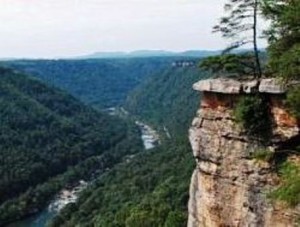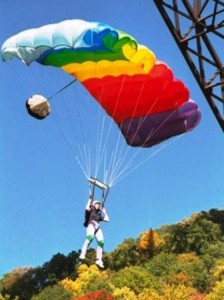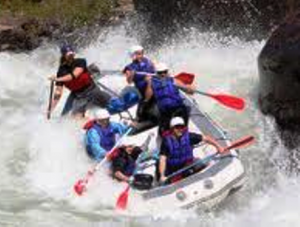» posted on Wednesday, March 27th, 2013 by Linda Lou Burton
Everything Old Is New
 Linda Burton posting from Charleston, West Virginia – “Our blueberry buttermilk pie is the absolute best,” Jeff said, giving me a nudge towards dessert; I had already polished off my grilled asparagus-bleu cheese sandwich. I settled on a piece “to go,” stating I had a busy afternoon ahead; that’s when the conversation segued into things to do in Charleston, and then, somehow, the New River Gorge. Today Jeff was my server in East End’s Bluegrass Kitchen; on other days, in season, he is a whitewater raft guide with New & Gauley River Adventures. I asked for a card, and I asked Jeff to tell me more about the Gorge. “The New River is misnamed,” Jeff said. “It’s actually the oldest river in the world, or at least the second oldest.” “Just how do you know that?” I asked, with a hint of disbelief in my voice. “Geologists,” he answered. “That’s what they say. It has to do with continental drift and lift and the way the earth has evolved.” Well I can look that up, I thought, and went on to inquire more about the New
Linda Burton posting from Charleston, West Virginia – “Our blueberry buttermilk pie is the absolute best,” Jeff said, giving me a nudge towards dessert; I had already polished off my grilled asparagus-bleu cheese sandwich. I settled on a piece “to go,” stating I had a busy afternoon ahead; that’s when the conversation segued into things to do in Charleston, and then, somehow, the New River Gorge. Today Jeff was my server in East End’s Bluegrass Kitchen; on other days, in season, he is a whitewater raft guide with New & Gauley River Adventures. I asked for a card, and I asked Jeff to tell me more about the Gorge. “The New River is misnamed,” Jeff said. “It’s actually the oldest river in the world, or at least the second oldest.” “Just how do you know that?” I asked, with a hint of disbelief in my voice. “Geologists,” he answered. “That’s what they say. It has to do with continental drift and lift and the way the earth has evolved.” Well I can look that up, I thought, and went on to inquire more about the New  River, and the Gorge. “It has the longest bridge in the world,” Jeff said. Oldest? Longest? I thanked Jeff for the info, and headed out for my afternoon rounds. Tonight, as I ate my blueberry buttermilk pie (absolute best) I spent some time with the World Almanac and confirmed Jeff’s other statements. Fact: the New River Gorge Bridge is the longest single-span steel arch bridge in the western hemisphere. It is 3,030 feet long, 876 feet high, took three years to build, and cost nearly $37 million. And one day a year, people are allowed to jump off it.
River, and the Gorge. “It has the longest bridge in the world,” Jeff said. Oldest? Longest? I thanked Jeff for the info, and headed out for my afternoon rounds. Tonight, as I ate my blueberry buttermilk pie (absolute best) I spent some time with the World Almanac and confirmed Jeff’s other statements. Fact: the New River Gorge Bridge is the longest single-span steel arch bridge in the western hemisphere. It is 3,030 feet long, 876 feet high, took three years to build, and cost nearly $37 million. And one day a year, people are allowed to jump off it.
 That is Bridge Day, West Virginia’s largest one-day festival, and one of America’s Top 100 Festivals. If you want to mark your calendar, it happens the third Sunday in October. BASE jumpers have their annual convention then; BASE stands for building, antenna, span, earth – the fixed objects from which these jumpers leap. It’s just seconds from bridge rail to splash down, so a well-orchestrated team of water safety, communications, and emergency personnel are on hand. Rappellers live it up on Bridge Day too; from the catwalk underneath the bridge; and those with absolutely no experience or skills simply walk across! The Hillbilly Hikers have an official VOLKSWALK; you can hike deep into the gorge and back, or walk across the bridge into Fayetteville. The historic Fayetteville Theater has weekend entertainment in the evenings.
That is Bridge Day, West Virginia’s largest one-day festival, and one of America’s Top 100 Festivals. If you want to mark your calendar, it happens the third Sunday in October. BASE jumpers have their annual convention then; BASE stands for building, antenna, span, earth – the fixed objects from which these jumpers leap. It’s just seconds from bridge rail to splash down, so a well-orchestrated team of water safety, communications, and emergency personnel are on hand. Rappellers live it up on Bridge Day too; from the catwalk underneath the bridge; and those with absolutely no experience or skills simply walk across! The Hillbilly Hikers have an official VOLKSWALK; you can hike deep into the gorge and back, or walk across the bridge into Fayetteville. The historic Fayetteville Theater has weekend entertainment in the evenings.
 Over a million visitors come to visit New River Gorge every year. AMTRAK’s Cardinal travels through the Gorge on its route from New York to Chicago; what a ride! There’s a rugged whitewater river flowing through deep canyons, steep canyon walls, and sandstone cliffs. The gorge cuts through the Appalachian Plateau; the river’s contorting course has exposed rocks that are over 1 billion years old. Most of the rocks are sandstone and shale; in the lower gorge around Batoff Mountain the rocks are among the oldest found in the gorge. Now, about Jeff’s claim that the New River is the “oldest river.” According to scientists, the New River was the main headwaters of an ancient watercourse called the Teays River, which flowed west to an immense inland sea that covered the central part of North America millions of years ago. Because the New River existed before the Appalachian Mountains, it was able to cut into them as fast as they were uplifted, and this very old river maintained its ancient course.
Over a million visitors come to visit New River Gorge every year. AMTRAK’s Cardinal travels through the Gorge on its route from New York to Chicago; what a ride! There’s a rugged whitewater river flowing through deep canyons, steep canyon walls, and sandstone cliffs. The gorge cuts through the Appalachian Plateau; the river’s contorting course has exposed rocks that are over 1 billion years old. Most of the rocks are sandstone and shale; in the lower gorge around Batoff Mountain the rocks are among the oldest found in the gorge. Now, about Jeff’s claim that the New River is the “oldest river.” According to scientists, the New River was the main headwaters of an ancient watercourse called the Teays River, which flowed west to an immense inland sea that covered the central part of North America millions of years ago. Because the New River existed before the Appalachian Mountains, it was able to cut into them as fast as they were uplifted, and this very old river maintained its ancient course.
 The New River is the only river that cuts through the ridge and valley province of the Appalachian Mountains instead of draining from or around them. That’s what made the river valuable as a way to connect the eastern United States to the central states, and why the CSX Railroad mainline runs through the gorge today. As it formed the gorge, the river sliced into and through thick coal-bearing rocks, exposing them. This made the coal relatively easy to remove and led to the industrialization of the New River Gorge. Some of the coal found in the New River Gorge is considered globally significant because of its exceptional quality and purity.
The New River is the only river that cuts through the ridge and valley province of the Appalachian Mountains instead of draining from or around them. That’s what made the river valuable as a way to connect the eastern United States to the central states, and why the CSX Railroad mainline runs through the gorge today. As it formed the gorge, the river sliced into and through thick coal-bearing rocks, exposing them. This made the coal relatively easy to remove and led to the industrialization of the New River Gorge. Some of the coal found in the New River Gorge is considered globally significant because of its exceptional quality and purity.
And then there’s recreation. Recreational opportunities in this 70,000 acre park are outstanding; no wonder a million people show up every year. Just look.
- Biking. Beautiful landscapes, a variety of difficult to not-so-difficult routes. Of special interest: Arrowhead Trail was created in 2011 by more than 1,000 members of the Order of the Arrow, Boy Scout’s honor society; Scouts provided 78,544 volunteer hours (valued at $1.6 million) to build this 12.8-mile stacked-loop trail in the Craig’s Branch area; four loops, moderate to difficult.
- Camping. Primitive camping along the river; seven camping areas in the park and one at Gauley River; all provide easy access to the river for fishing and swimming. Two areas available for group camping too.
 Climbing. Over 1,400 established rock climbs within 63,000 acres; The New is one of the most popular climbing areas in the country. Cliffs are very hard sandstone, from 30 to 120 feet in height; very featured with an abundance of crack and face routes. Climbing season April-November.
Climbing. Over 1,400 established rock climbs within 63,000 acres; The New is one of the most popular climbing areas in the country. Cliffs are very hard sandstone, from 30 to 120 feet in height; very featured with an abundance of crack and face routes. Climbing season April-November.- Fishing. Diversity of fish; many public access points; spring and fall are best fishing times as water temperatures are in transition and fish are more aggressively feeding then.
- Hiking. Peaceful forest trails, superb overlooks, historic scenery; trails from 1/4th mile to 7 miles; flat and smooth to steep and challenging.
- Nearby Attractions. Bluestone National Scenic River; Gauley River National Recreation Area. The Gauley is a world-class destination for whitewater boaters, it drops 28 feet per mile through a gorge averaging 500 feet in depth.
- Ranger Programs. Programs throughout the year to learn about the natural world, and the people who shaped the past; learn about coal mining, railroading, logging, river safety.
- Scenic Drives. Fayette Station Road tour takes visitors from the rim of the gorge down to the bottom, passing under the New River Gorge Bridge on the way.
 Whitewater.53 miles of free-flowing New River, beginning at Bluestone Dam and ending at Hawks Nest Lake. The upper part of the river consists primarily of long pools, and relatively easy rapids up to Class III. The lower section of river is often referred to as “the Lower Gorge,” with rapids ranging in difficulty from Class III to Class V. Licensed outfitters offer guided trips with trained guides, equipment, instruction, transportation to and from the river, and meals; trips vary in length from several hours to several days, and offer different degrees of difficulty, from peaceful float and fishing trips to crashing whitewater.
Whitewater.53 miles of free-flowing New River, beginning at Bluestone Dam and ending at Hawks Nest Lake. The upper part of the river consists primarily of long pools, and relatively easy rapids up to Class III. The lower section of river is often referred to as “the Lower Gorge,” with rapids ranging in difficulty from Class III to Class V. Licensed outfitters offer guided trips with trained guides, equipment, instruction, transportation to and from the river, and meals; trips vary in length from several hours to several days, and offer different degrees of difficulty, from peaceful float and fishing trips to crashing whitewater.
Which brings me back to Jeff. That’s Jeff LeVesque, and he is a guide with New & Gauley River Adventures, 1-800-SKY-RAFT, http://www.gauley.com/whitewater_rafting.htm
About the New River Gorge http://www.nps.gov/neri/index.htm

